Genocide, Again
Words by Dalene Heck / Photography by Pete Heck
It is a heavy day for anyone who decides to visit both the Tuol Sleng Genocide Museum and the Choeung Ek Killing Fields in one excursion.Both now stand as important memorials to when the Khmer Rouge ruled Cambodia with a ruthless will from 1975 to 1979, orchestrating the Cambodian Genocide and slaughtering about two million of their own. A “social re-engineering” via ethnic cleansing, as it were.
The Genocide Museum was once a high school. Under the Khmer Rouge it became an execution center known as Security Prison 21 (S-21), and was one of about 150 throughout the country.
Choeung Ek was once an orchard. But now it is the best known “Killing Field” used by the barbarous rulers, one of many mass gravesites which hold over a million of those tortured and murdered.
To see them both is vital to understanding the troubled past of the Kampuchea – to give some explanation as to why there are so few elderly citizens, and to encourage appreciation for the congenial spirit of those who remain, given how much they have endured.
It’s not an easy day when visiting these places. But it is an important one.
security prison 21
I’ve been here before, I thought to myself, as soon as I entered.
I hadn’t, actually.
My tongue felt swollen and expanded to fill each side of my cheeks. It prevented words from escaping and bile from forming. I felt a palpable evil, I was sure of it, but maybe it just existed in my own memory, maybe the knowledge of the horrors of ever-repeating history still hadn’t fully sunken in yet.
Maybe because they are unbelievable.
In front of me, haphazardly constructed detention cells, no more than a couple of meters by one. Room after room of yellow and white checkered floors, dank and dark, save for small spotlights through gated windows and small slots in cement.
Barbed wire. Torture tools – some that even needed explaining as this naive mind couldn’t conjure up the image of their actual use.
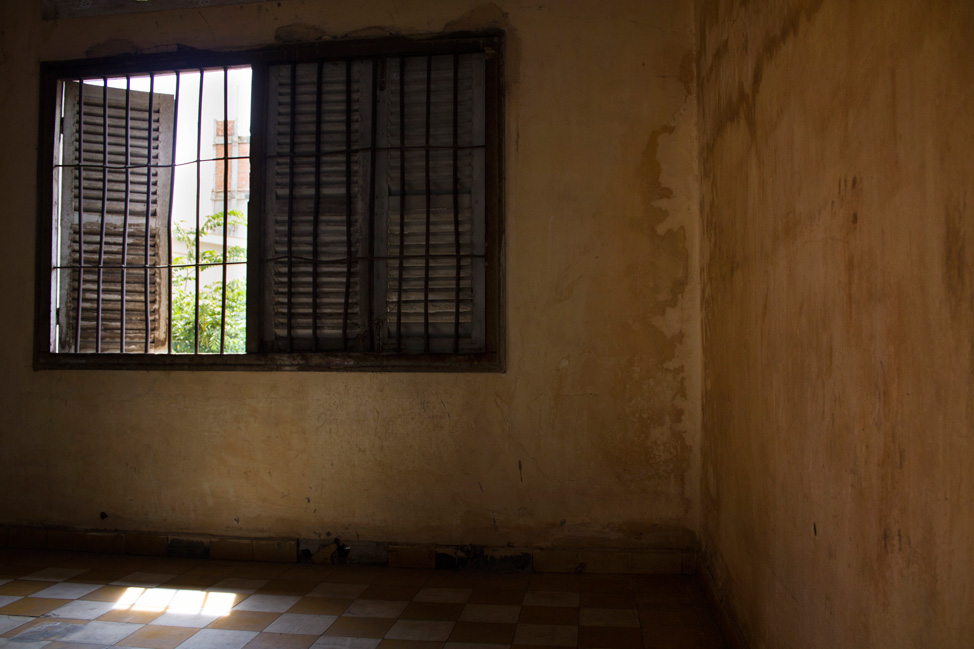
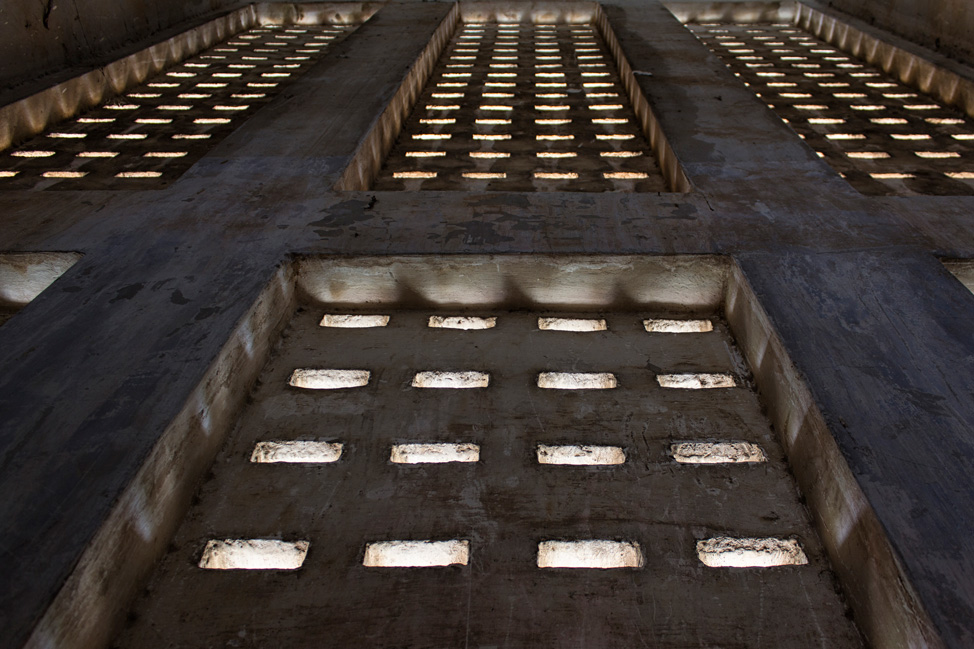
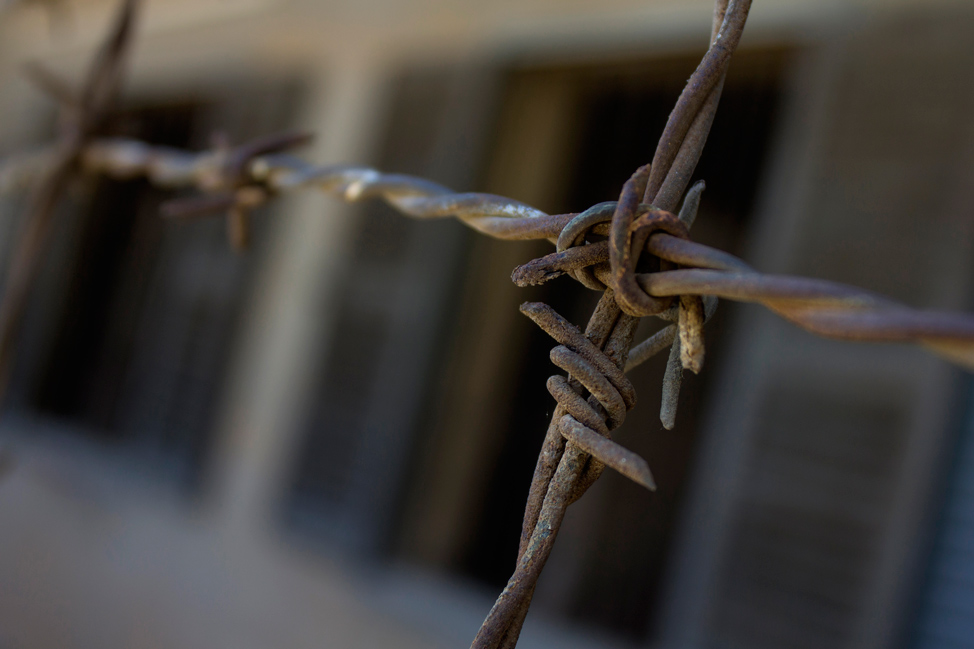
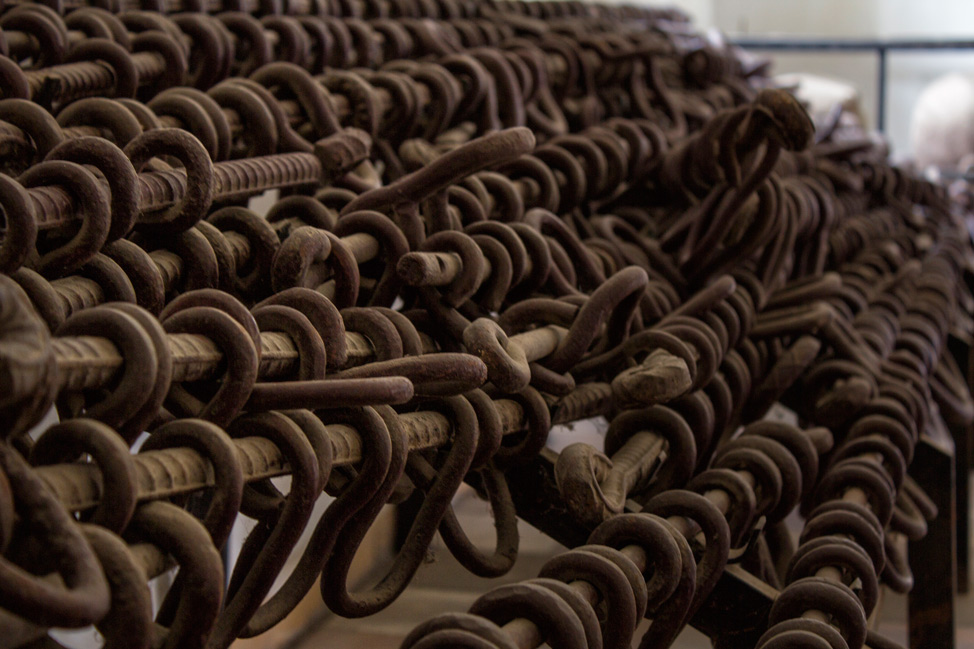
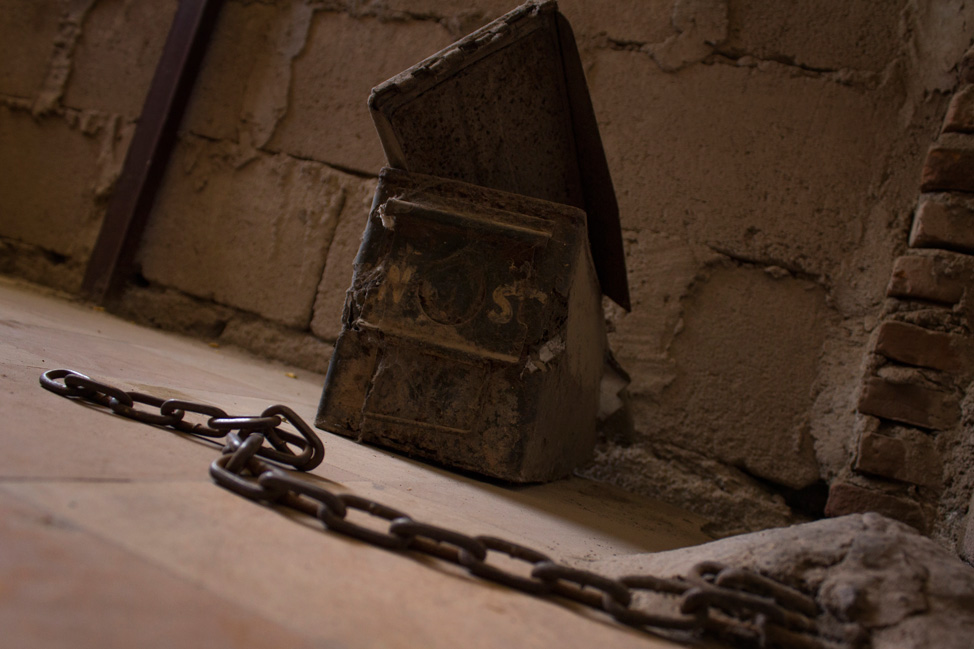
Lofty placards stood with rules that had to be followed under threat of death.
You are strictly prohibited to contest me.
Don’t be a fool for you are a chap who dare to thwart the revolution.
You must immediately answer my questions without wasting time to reflect.
If you don’t follow all the above rules, you shall get many lashes of electric wire.
While getting lashes or electrification you must not cry at all.
Faces. Photos of the tortured, photos of the dead. I could see the faces of people I knew. I focused for several minutes on my nephew – the same full lips, the same shape of face. Same age too, I guessed, separated by mere decades and the lottery of birth.
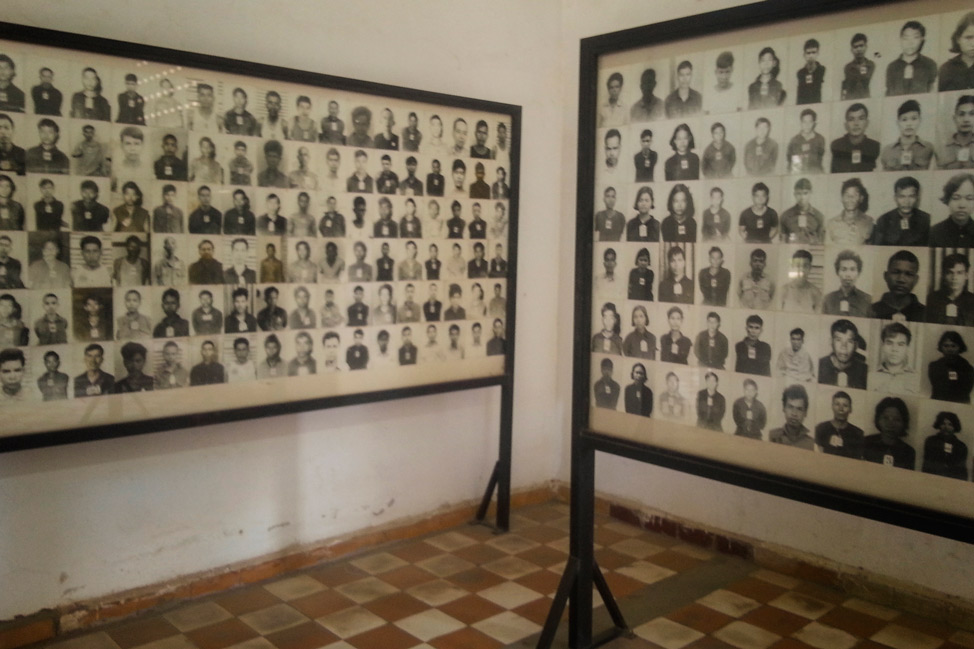
I’ve been here before. Mankind has been here before. We’ve seen entire societies ripped apart – people from their families, from their religious beliefs, from all they believed to be good about humanity.And in many parts of the world, we are still there.
When will we learn?
choeung ek
Somehow, this Killing Field seemed remarkably peaceful.
Maybe it was just that my senses were dulled, or I wanted so badly to dispel the despair that lingered after our visit to the genocide museum. But the long shadows from the towering trees were an inviting escape from the hot sun, and bright flowers burst in several spots. Indication of the atrocities committed here were not so readily visible.
Remnants of the horrors instead sat beneath our feet, in mass graves. Some of the sunken ground was protected by bamboo fences enshrined with colourful bracelets, others were not. If we kicked around enough of the loose dirt anywhere, it was possible that we would uncover something new. Clothing, maybe even a tooth.
We chose to tread carefully.
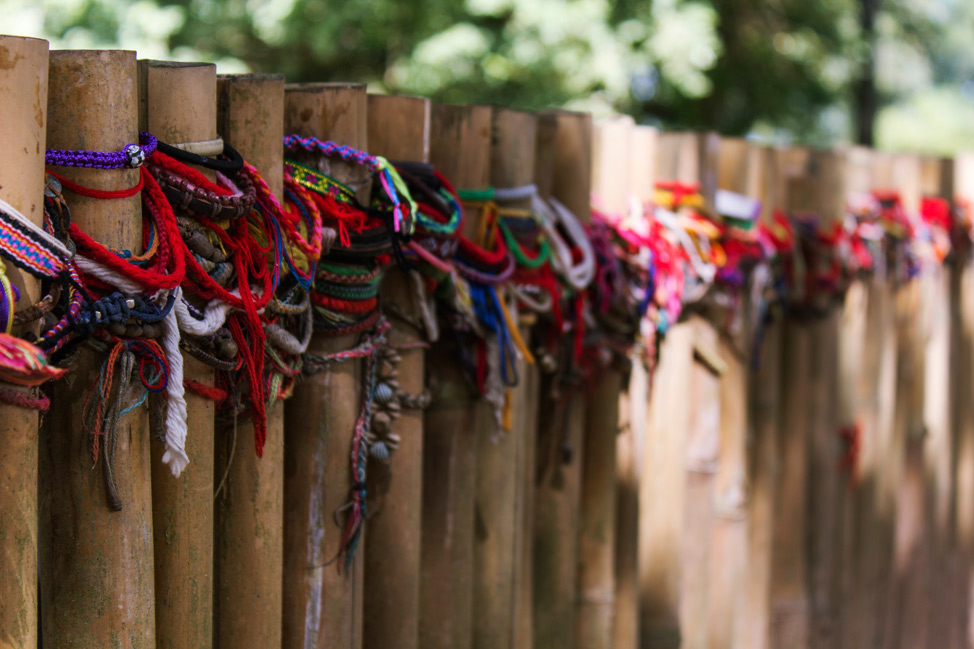
Stories and data rolled off of the informative audio guide, but with few visuals to accompany it, escaping this particular memorial without much affect seemed possible. We took our time, going off-path to sit on a bench near a large lake. We watched one man cast out several fishing lines and a small boy poke holes in a plastic sheet with a sharp stick.
It was quiet, calm, affable even.
But then, it wasn’t.
Because there was this tree.
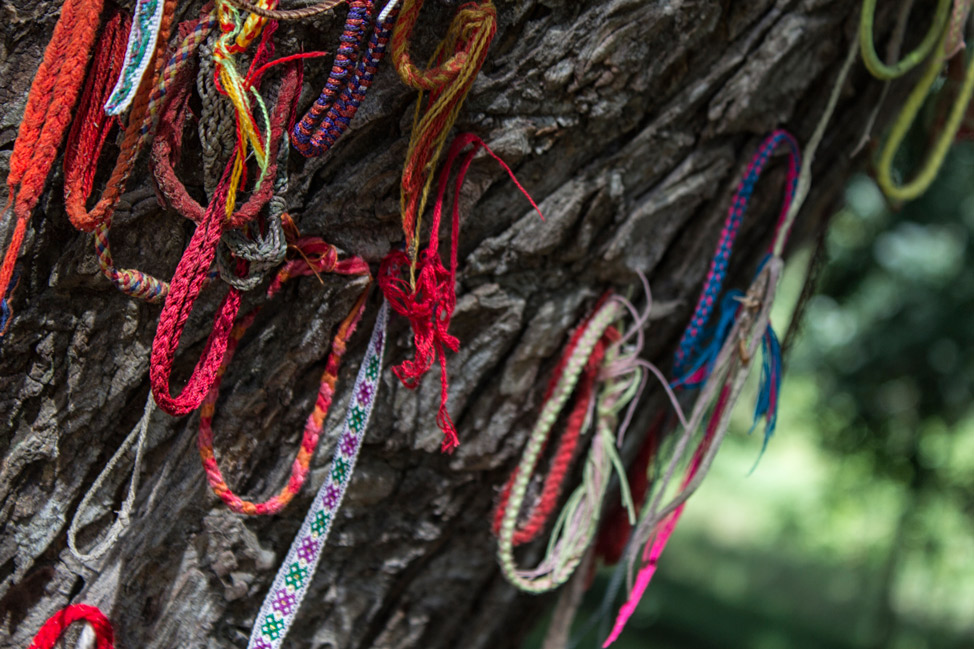
Branches split about ten feet up, and then again and again, darting in every direction. It produced full leafy limbs against the bright blue sky. Birds sat chirping, their glittering song in blunt contrast to the speech rolling through my head phones.
I did not stand alone. There was an accumulation of visitors, all staring directly at the tree, most brushing away tears.
Listening.
Staring.
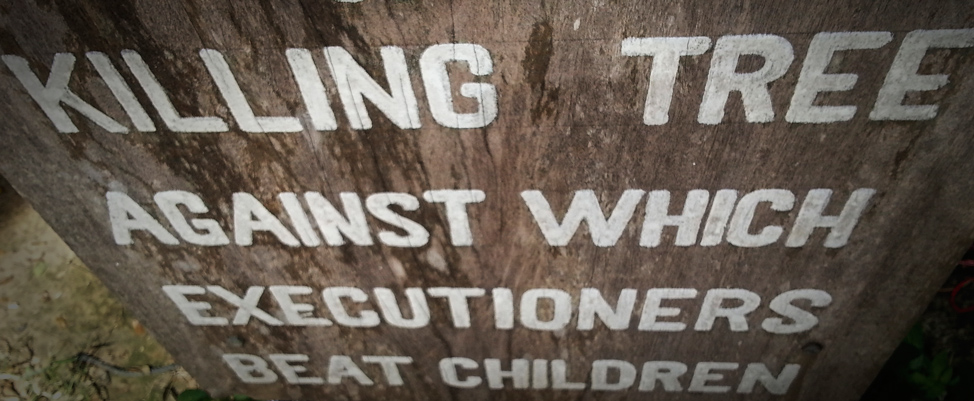
The audio guide stated that when this tree was first discovered, it was covered with hair and bloodstains, bone and brain fragments. It was determined that soldiers would grab babies by their ankles and smash their heads against the tree, often in front of their mothers, who had also probably just been raped. They would all be tossed in a mass grave together.Why so mercilessly murder babies? To dig up the grass, one must even dig up the roots, a was a common Khmer mantra. The infants were killed to prevent revenge.
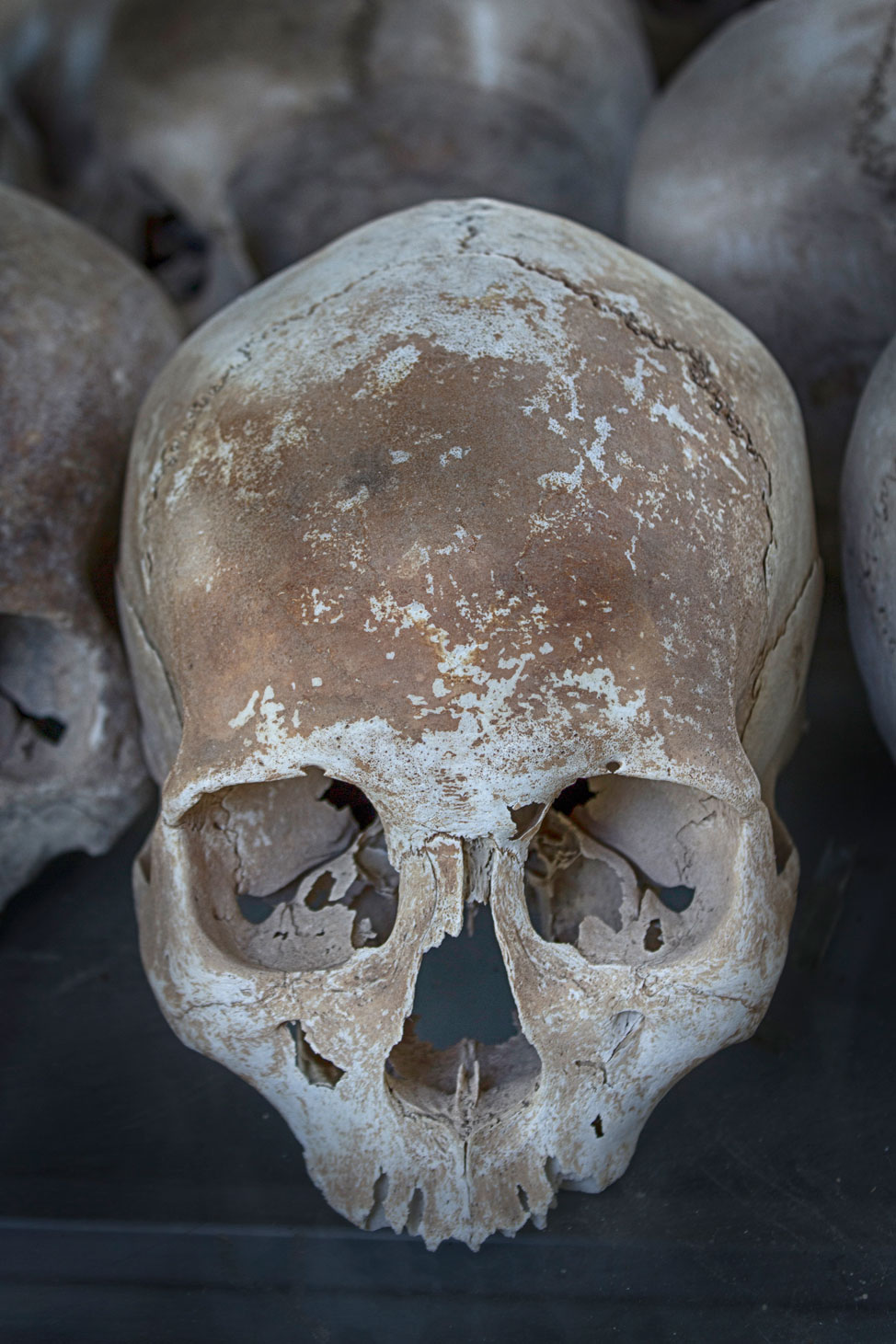
It was at that point in which I realized that I truly believe nothing can shock me anymore.
The rest of the memorial, with over 9,000 bodies discovered and probably many more yet undisturbed, and even with a collection of skulls on display which show exactly how and where trauma was inflicted, could not be compared to that tree.
Can anything?
I left those peaceful yet terrorizing fields completely numb and wordless. Reeling. And as with our visit earlier this year to Auschwitz, still processing the impact.

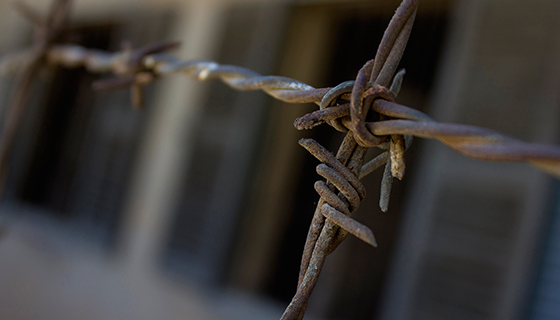
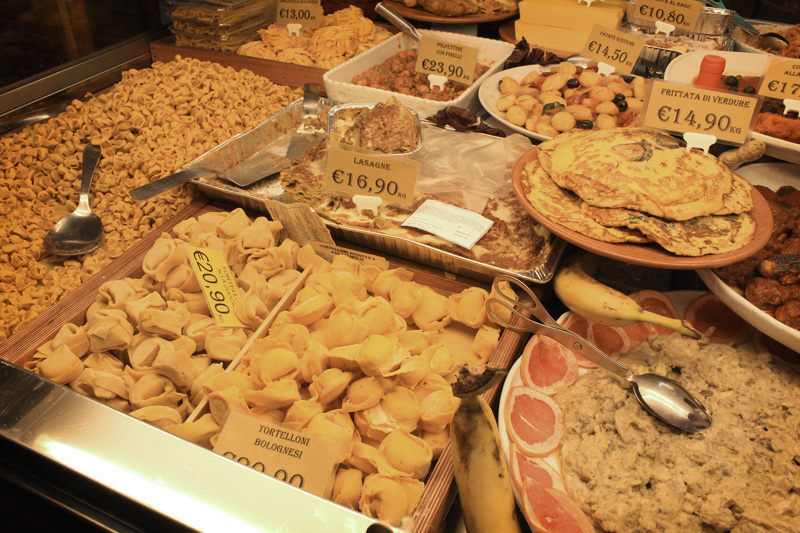
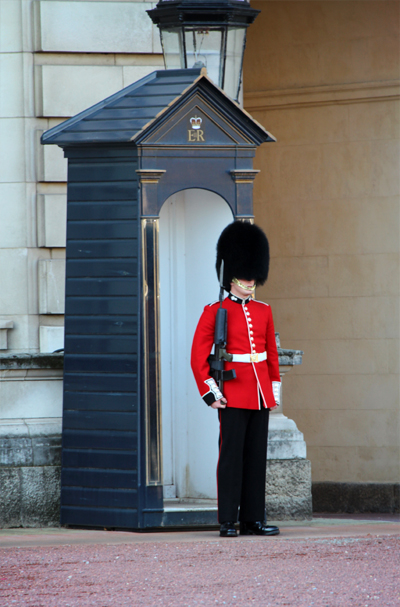
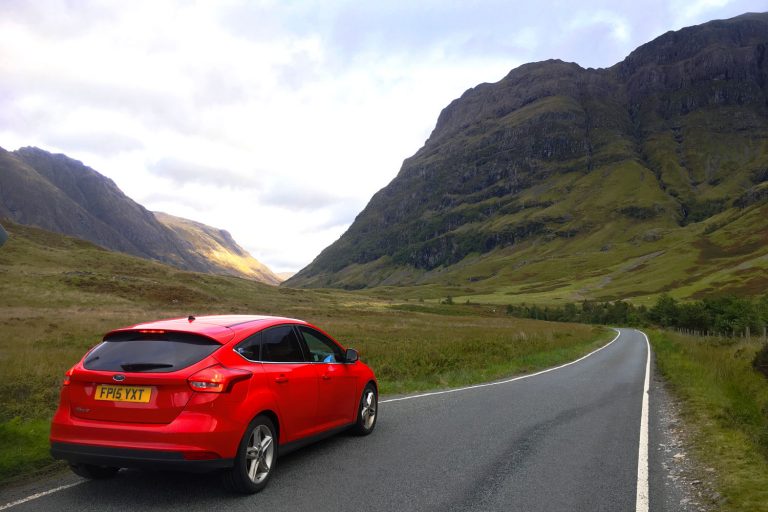
It’s impossible to wrap your mind around how people can be do incredibly evil.
Goosebumps. This post gave me goosebumps.
I feel like I’ve been following in your footsteps this year – I just wrote my own post about my chilling visit to Auschwitz, and I’ll be visiting both of these sites in Cambodia in just a handful of weeks. Definitely not happy places. But I feel an obligation to see them and try to understand them, if only for the sake of the memory of all the people who suffered there.
I’ll be interested to read about how you feel after visiting both Auschwitz and Cambodia so closely together. They are both so difficult.
I honestly don’t even know what to say. I have tears in my eyes. Thank you for sharing this with the world, even though it’s almost unbearable to read.
Thanks Andi, (and sorry)!
Oh my goodness. I’m sitting here with tears in my eyes. I have been to Phnom Penh twice and both times, would have loved to visit both the museum and the field. I know it isn’t easy, but I feel the best way to understand a culture, a place, is to take the good and the tragic, heart-breaking bad. Like you, I went to Auschwitz-Birkeanu, not because I wanted to, but because I KNEW I HAD TO. Without education, without understanding, without sharing stories like this, it makes those deaths, those horrors, all for nothing. Places like these make us realize the extent of evil humans can have, and remind us there is still good in the world in those tears we shed, those stories we can share to others. I will go back to PP, simply because I HAVE to go to these two places and experience them for myself and take that sadness, that shame for how evil people can be, with me into the world. Thank you for sharing this. <3
I’m glad you will be sure to get back there Diana, it is such an important place to visit, especially because it really wasn’t that long ago. It speaks volumes of modern-day Cambodia.
I agree with the other comments, that it is our duty and obligation to bear witness to these places.
I am always stunned at all that we are capable of doing. Our cruelty seems to have no limits.
Thankfully, neither does our love.
Thanks for this reminder.
“Thankfully, neither does our love.” So true, but hard to see sometimes after visiting a place like this.
I think that unless you visit somewhere like S21, you just can’t really understand modern-day Cambodia. It is horrifying and horrific the things one learns by going there, but it is important and has shaped the face of the country, leaving scars across its cheek and brow.
One thing I found really interesting when we visited S21 is that the foreigners seemed more disturbed and upset by the place than the local Khmers. I suppose they have had to carry this burden for a long time now and most of them, it seems, have actually moved on and laid the past to rest. For those of us just discovering this dark corner of human history, it is not so easy to find the peace, I think.
I confess that I felt so drained after our hours spent at S21 that I didn’t have the heart or the inclination to go to the Killing Fields themselves. After seeing the documentaries and reading everything we had, seeing the faces of the victims, I just didn’t think another trip would add to my own journey. For me, the fact that a school, a place of learning, was turned into a prison and place of torture was enough.
It’s interesting, your comment about foreigners and the Khmer people, as we found it exactly the same way. Pete even chastised a local man for laughing at one of the exhibits – it was Pete’s impulse to do so, finding it reprehensible – but we discussed it later that it might just be a coping mechanism. None of us can even possibly understand.
Beautifully written. Thank you for sharing
The brutality of the Khmer Rogue is just obscene. It is incredible that this doesn’t get taught in high school ( I didn’t know about it until visiting Cambodia).
Wonderful pictures for such a brutal time in history. It is amazing how wonderful Cambodians still are despite it all.
You are so right, I can’t understand how it is not being taught in schools. I’ll admit not even knowing a quarter of the story before visiting.
Wow. Beautifully written, Dalene. Having been to both places I totally get the level of emotion they bring to bear. Especially that tree. We were fortunate to have our kids there with us – both 12 at the time. Bearing witness to the atrocities we can inflict on humankind was an important experience to give to our children. I can still hear the horrible music they played ringing in my headset as we listened with horror. Marley left a bracelet along a bamboo fence.
What a heavy, emotional day. The pictures are very well done as always. Thank you for sharing.
I visited S21 and the killing fields when I was 17 during a humanitarian aid trip in Cambodia. Because it was part of a school trip, I studied the Khmer regime thoroughly, learning about things in great detail that I wish I could forget, things that are just so horrific. And then seeing it in real life after studying it was unreal. The shock and horror that I saw within the walls of the prison and on the fields have stuck with me ever since. To the point that I cannot fathom ever going again – I couldn’t make myself go to Auschwitz for example – the thought of it actually made me sick.
But these places serve as a reminder to how terrible we can be to one another and hopefully prevent things like this happening again. It is amazing the resilience of the people in Cambodia.
A powerful experience. I hope one day we learn… I like to think that the surge of new people traveling will help…
I read your coverage of your Auschwitz visit, and just like then, this was a tough but worthwhile read. Your sensitivity and frankness handles a horrible subject gracefully. I had to stop though, at the tales of babies against the tree. It reminded me of very similar stories I read in middle school while doing research on the Holocaust, and it left me a total mess for weeks afterward. I hope to eventually visit one or both of these places, and while I’m not sure I’ll ever be really ready, thanks for a little preparation in how it might feel to be there.
I can’t control my tears. This is pure obscene. I even don’t know what to say.
As a species, we are capable of both the horrific and the sublime. The Khmer genocide was undoubtedly one (amongst many) of the humanistic low points of the 20th century. Knowing of the country’s brutal history before arriving in Phnom Penh (I’m a movie buff, and had seen The Killing Fields at a somewhat young age), I was taken aback by the Khmer people’s apparent insouciance concerning such a violent chapter of their nation. Since Steph and you guys got similar reactions, I’d agree with you and assign it to a coping mechanism. Still, it was bizarre to see them talking about it – it seemed they were talking about another country and another people… Fantastic piece. Good luck and hope you are enjoying your time at home!
It scares me that we as humans can transform into someone who can be responsible for such pain on others. When I read this type of thing I hope that we have learnt but then it just repeats somewhere else currently Syria and the Sudan….when will we learn 🙁
We will be going there in just a couple of weeks and it’s really impossible to fathom what it will be like. I’ve been to Dachau in Germany, which was incredibly hard, but it sounds like this exhibit is even more…raw. I think that might be the right word for it. But either way, it’s important and we’re going.
We went to both of these places and it was so traumatic for us as visitors; i can barely understand what it must have been like for the people. I still feel haunted by it
This is so heartbreaking. You’re right, the tree has the greatest impact. It’s horrific.
I recently returned from Cambodia and found the country to magical and disturbing all at the same time. I love your images and for those lucky to have visited they bring back vivid memories and emotions. Thanks. Tim